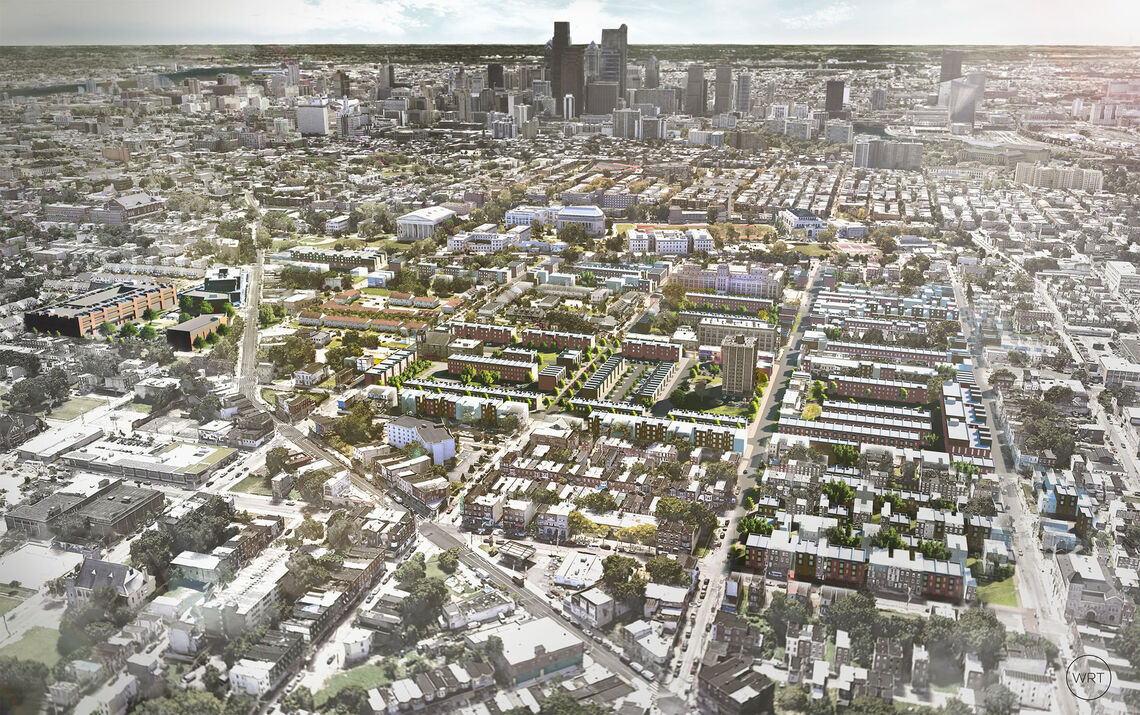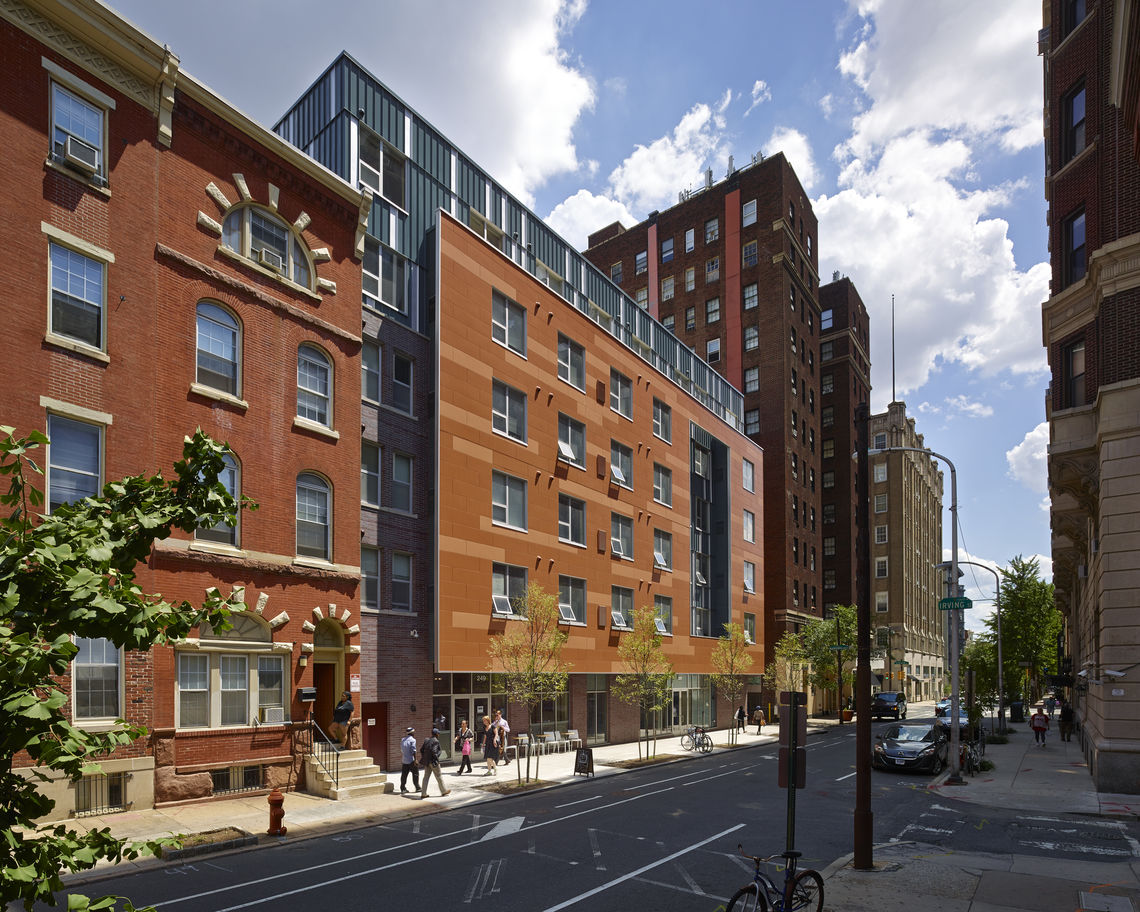As one of our home cities (San Francisco being the other), we are quite partial to the work being done here to make our neighborhoods more equitable, livable, and resilient places for people to thrive.
To all those arriving at #NPC23 this week, welcome to Philly! WRT is looking forward to being active in the conference, including the following sessions.
Change is an Opportunity
Equity and Public Health in Trenton and Philadelphia
Woo Kim (WRT) with Julia Taylor, AICP and Morgan Hutchinson, MD
April 2, 11:30 am – 12:15 pm
Consider two predominantly Black communities—one in Trenton, one in Philadelphia—that are at a crossroad of poverty and change. Both partnered with local medical institutions (Capital Health and Jefferson Health, respectively) to address public health crises while undergoing much-needed neighborhood planning.
Presenters share a story of urban poverty and inequity and how they are rewriting that narrative with healing and recovery. Learn how to engage non-conventional professionals to address planning issues; hospital administrators and frontline workers bring unique perspectives to the planning process that yield unorthodox outcomes.
The Capital Health/Trenton Health team describes how they are leveraging recent federal, place-based planning grants to invest in the North Trenton neighborhood. The five-year, $10 million Trenton Neighborhood Initiative is committed to improve housing, employment, and social and digital outcomes. Jefferson Health’s COVID-19 Mobile Unit offers targeted, human-centered care to vulnerable Philadelphia communities, based on a compact of trust among health care delivery experts, sponsors, and community partners.
Woo Kim: Equity and Public Health in Trenton and Philadelphia
Rebuilding Sharswood: A Decade of Neighborhood Transformation in Philadelphia (mobile workshop)
Woo Kim (WRT) w/ Mark Dodds and Andrew Meloney, AICP
April 3, 1:15 pm – 4:45 pm
Philadelphia's Sharswood community is ready to herald in a new era. After decades of disinvestment and concentrated poverty, the neighborhood’s reputation was dangerous and hostile. Once a hub of African American arts, theater, and activism, its vibrant commercial and housing markets were replaced with crime and blight. Businesses and institutional partners abandoned Sharswood and the neighborhood’s two main public schools closed.
In 2013, the Philadelphia Housing Authority (PHA) embarked on a planning process funded by HUD’s Choice Neighborhoods Initiative to develop a resident-driven transformation plan that leveraged experience from implementing nearby North Central Choice.
Fast forward a decade and Sharswood is unrecognizable. For example:
- The Stephen Klein Wellness Center is countering the troubling social determinants of health;
- Newly constructed units promote home ownership and build wealth;
- By leveraging the mayor’s Rebuild initiative, millions were invested in recreation centers and a library;
- Abandoned schools came back to life;
- New parks and affordable housing rose out of vacant lots;
- A new grocery store opened in what had been a food desert; and
- When businesses were fleeing the neighborhood, PHA invested in its new headquarters.

Building a Constituency of Planning Advocates
w/ Donna Carney and Terri Francis
April 1, 11:00 – 11:45 am
In many communities, residents are rarely asked their opinions, let alone given a seat at the planning table. This presentation explores three community leadership models that take a “long-game” approach to building a more equitable constituency for planning and to increasing diversity around the table and within the profession. All three programs envision a future where every resident is equipped as an advocate and agent of positive neighborhood change. They use a cohort format to build stronger cross-neighborhood networks and relationships.
The Philadelphia Citizens Planning Institute came into being in 2010 as the “outreach and education” entity within the Philadelphia City Planning Commission. More than 700 citizen planners – alumni of the biannual courses – serve as “bridge-builders” between staff planners and the neighborhoods they represent. Newport News started a Neighborhood Leadership Series in 2017 to engage a highly distressed community as part of the Marshall-Ridley Choice Neighborhood planning process. Seven cohorts later, it has expanded citywide, encouraging residents to become local leaders of change. Since 2018, the Center for Community Planning has immersed elementary, middle-, and high-school students in New Jersey in real-world redevelopment proposals, inspiring them to engage in community development.
Philadelphia Gayborhood: Past and Future (mobile workshop)
Paul Lawrence McGehee, II with Peter Barnard, AICP, Max Dickson, and Bob Skiba
April 1, 2:00 pm – 5:00 pm
Visibility and the capacity to claim public space have been central to the movement for queer civil rights in cities across the country. Philadelphia’s history of queer activism, creative expression, and community can be read in numerous areas across the city. The Gayborhood in the heart of downtown is a relatively recent focal point, but a significant one as it became openly recognized in the era of growing queer rights and understanding that began in the 1970s.
Track the development of the Gayborhood as a distinctive Philadelphia cultural district through its most important sites. These include the William Way Center, with its archives and multi-generational programming; locales important to queer BIPOC Philadelphians; the John C. Anderson Senior Apartments; and every day and celebratory spaces serving the multitude of queer communities across the region.
Queer and queer-allied planners and designers — whose work and lives connect to this neighborhood and its programming initiatives — offer insights into past and planned policies and projects that shape neighborhoods. Learn how queer communities in Philadelphia have transformed public space that enables queer belonging and community-building while maintaining public-realm requirements.

A Resilient Vision for Historic FDR Park (mobile workshop)
Charles Neer (WRT) with Allison Schapker and Justin DiBerardinis
April 3, 1:45 pm – 4:45 pm
Philadelphia’s 348-acre FDR Park—designed by the Olmsted Brothers in 1914 and the site of the city’s 1926 Sesquicentennial Exposition — is both the primary recreational amenity for 170,000 South Philadelphia residents and a key asset that performs critical environmental functions amidst a changing climate. A plan now being implemented calls for $250 million in investment over the next decade to reclaim the park’s historic vision, restore its environmental functions, and nurture its role as South Philadelphia’s cultural, recreational, and economic centerpiece.
Learn about the robust civic engagement process that drove the plan; hear about the challenges of planning for a complex, high-profile park with regional significance; and tour the latest achievements, including the future Welcome Center and Pattison Playground.
During the COVID-19 pandemic, when use of the park’s golf course was restricted, residents enjoyed expanding meadows. The plan has since been revised to include new areas of forested wetlands, thereby adapting to ecological and community needs while improving the park’s function.